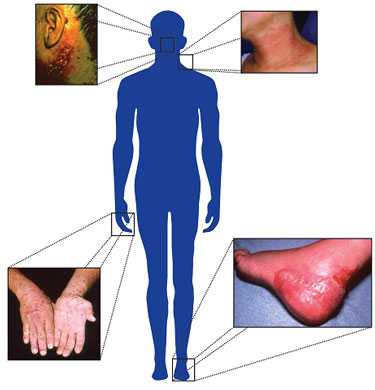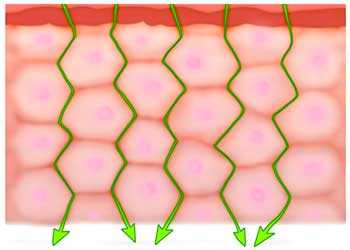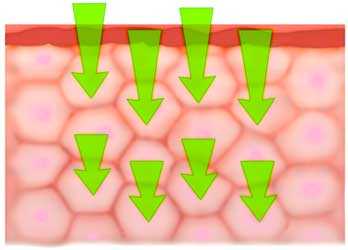SKIN EXPOSURES & EFFECTS
Overview
It is estimated that more than 13 million workers in the United States are potentially exposed to chemicals that can be absorbed through the skin. Dermal exposure to hazardous agents can result in a variety of occupational diseases and disorders, including occupational skin diseases (OSD) and systemic toxicity. Historically, efforts to control workplace exposures to hazardous agents have focused on inhalation rather than skin exposures. As a result, assessment strategies and methods are well developed for evaluating inhalation exposures in the workplace; standardized methods are currently lacking for measuring and assessing skin exposures.
Skin Notation (SK) Profiles
NIOSH has developed a strategy for assigning multiple skin notations (SK) capable of delineating between the systemic, direct and immune-mediated effects caused by dermal contact with chemicals.

OSD are the second most common type of occupational disease and can occur in several different forms including:
- Irritant contact dermatitis,
- Allergic contact dermatitis,
- Skin cancers,
- Skin infections,
- Skin injuries, and
- Other miscellaneous skin diseases.
Contact dermatitis is one of the most common types of occupational illness, with estimated annual costs exceeding $1 billion.
Occupations at Risk



Workers at risk of potentially harmful exposures of the skin include, but are not limited to, those working in the following industries and sectors:
- Food service
- Cosmetology
- Health care
- Agriculture
- Cleaning
- Painting
- Mechanics
- Printing/lithography
- Construction
Anatomy and Functions of the Skin
The skin is the body’s largest organ, accounting for more than 10 percent of body mass. The skin provides a number of functions including:
- protection,
- water preservation,
- shock absorption,
- tactile sensation,
- calorie reservation,
- vitamin D synthesis,
- temperature control, and
- lubrication and waterproofing.
Skin Hazards

Causes of OSD include chemical agents, mechanical trauma, physical agents, and biological agents.
- Chemical agents are the main cause of occupational skin diseases and disorders. These agents are divided into two types: primary irritants and sensitizers. Primary or direct irritants act directly on the skin though chemical reactions. Sensitizers may not cause immediate skin reactions, but repeated exposure can result in allergic reactions.
- A worker’s skin may be exposed to hazardous chemicals through:
- direct contact with contaminated surfaces,
- deposition of aerosols,
- immersion, or
- splashes.
- A worker’s skin may be exposed to hazardous chemicals through:
- Physical agents such as extreme temperatures (hot or cold) and radiation (UV/solar radiation).
- Mechanical trauma includes friction, pressure, abrasions, lacerations and contusions (scrapes, cuts and bruises).
- Biological agents include parasites, microorganisms, plants and other animal materials.
Dermal Absorption
Dermal absorption is the transport of a chemical from the outer surface of the skin both into the skin and into the body. Studies show that absorption of chemicals through the skin can occur without being noticed by the worker, and in some cases, may represent the most significant exposure pathway. Many commonly used chemicals in the workplace could potentially result in systemic toxicity if they penetrate through the skin (i.e. pesticides, organic solvents). These chemicals enter the blood stream and cause health problems away from the site of entry.
The rate of dermal absorption depends largely on the outer layer of the skin called the stratum corneum (SC). The SC serves an important barrier function by keeping molecules from passing into and out of the skin, thus protecting the lower layers of skin. The extent of absorption is dependent on the following factors:
- Skin integrity (damaged vs. intact)
- Location of exposure (thickness and water content of stratum corneum; skin temperature)
- Physical and chemical properties of the hazardous substance
- Concentration of a chemical on the skin surface
- Duration of exposure
- The surface area of skin exposed to a hazardous substance
Research has revealed that skin absorption occurs via diffusion, the process whereby molecules spread from areas of high concentration to areas of low concentration. Three mechanisms by which chemicals diffuse into the skin have been proposed:
- Intercellular lipid pathway (Figure 1)
- Transcellular permeation (Figure 2)
- Through the appendages (Figure 3)

Figure 1: Intercellular lipid pathway
As shown in Figure 1, the stratum corneum consists of cells known as corneocytes. The spaces between the corneocytes are filled with substances such as fats, oils, or waxes known as lipids. Some chemicals can penetrate through these lipid-filled intercellular spaces through diffusion.

Figure 2: Transcellular permeation
As shown in Figure 2, another pathway for chemicals to be absorbed into and through the skin is transcellular, or cell-to-cell, permeation whereby molecules diffuse directly through the corneocytes.

Figure 3: Through the appendages (hair follicles, glands)
As shown in Figure 3, the third pathway for diffusion of chemicals into and through the skin is skin appendages (i.e., hair follicles and glands). This pathway is usually insignificant because the surface area of the appendages is very small compared to the total skin area. However, very slowly permeating chemicals may employ this pathway during the initial stage of absorption.
Contact Dermatitis
Contact dermatitis, also called eczema, is defined as an inflammation of the skin resulting from exposure to a hazardous agent. It is the most common form of reported OSD, and represents an overwhelming burden for workers in developed nations. Epidemiological data indicate that contact dermatitis constitutes approximately 90-95% of all cases of OSD in the United States. Common symptoms of dermatitis include:
- Itching
- Pain
- Redness
- Swelling
- The formation of small blisters or wheals (itchy, red circles with a white centre) on the skin
- Dry, flaking, scaly skin that may develop cracks
Occupational contact dermatitis is frequently divided into two categories:
- Irritant contact dermatitis (ICD) is a non-immunologic reaction that manifests as an inflammation of the skin caused by direct damage to the skin following exposure to a hazardous agent. The reaction is typically localized to the site of contact. Available data indicates that ICD represents approximately 80% of all cases of occupational contact dermatitis.
ICD may be caused by phototoxic responses (e.g., tar), acute exposures to highly irritating substances (e.g., acids, bases, oxiding/reducing agents), or chronic cumulative exposures to mild irritants (e.g., water, detergents, weak cleaning agents).
- Allergic contact dermatitis (ACD) is an inflammation of the skin caused by an immunologic reaction triggered by dermal contact to a skin allergen. For ACD to occur, a worker must be first sensitized to the allergen. Subsequent exposures of the skin to the allergenic agent may elicit an immunologic reaction resulting in inflammation of the skin. The reaction is not confined to the site of contact and may result in systemic responses.
ACD may be caused by industrial compounds (i.e. metals, epoxy and acrylic resins, rubber additives, chemical intermediates), agrochemicals (i.e. pesticides and fertilizers), and commercial chemicals.
Because the symptoms and presentation of ICD and ACD are so similar, it is extremely difficult to distinguish between the two forms of contact dermatitis without clinical testing (e.g. patch testing). The severity of contact dermatitis is highly variable and depends on many factors including:
- Characteristics of the hazardous agent (irritant and/or allergen)
- Concentration of the hazardous agent (irritant and/or allergen)
- Duration and frequency of exposure to the hazardous agent (irritant and/or allergen)
- Environmental factors ( e.g., temperature, humidity)
- Condition of the skin (e.g., healthy vs. damaged skin, dry vs. wet)
- Page last reviewed: July 2, 2013
- Page last updated: April 30, 2012
- Content source:
- National Institute for Occupational Safety and Health Health Effects Laboratory Division (HELD)


 ShareCompartir
ShareCompartir